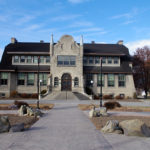Home »

Are Canadians not interested in their history?
 “Perceptions,” by Gerry Warner
“Perceptions,” by Gerry Warner
Op-Ed Commentary
A few years ago, on a summer vacation in Montana, I saw something I never expected to see. Driving through ranching country near the Missouri River south of Great Falls, I saw a historic monument on the side of the road that looked interesting. Being the history nut that I am, I pulled over to see what the bronze plaque said about this isolated part of the Treasure State.
Imagine my surprise when the sign was about a famous Canadian – not American – who fled Canada to avoid being captured or killed by his political enemies! This Canadian was born in St. Boniface, Manitoba in 1844, fought hard for the rights of Metis people but today is barely known by most Canadians outside of Manitoba.
A charismatic leader, he was elected to Parliament three times but denied a seat and twice forced to flee to the US to escape persecution. In May 1885, he led the North-West Rebellion but was captured at the Battle of Batoche, put on trial in Regina and hung after being convicted for high treason. But today Metis leader Louis Riel is considered a hero and called the “Father of Manitoba” for his courageous battle to recognize the rights of Metis people.
So, you might well ask, what piqued my interest in Riel so much?
Well, this week for the first time in a long time, I made a visit to Fort Steele Heritage Town to renew my interest in local history. I’m pleased to report the heritage village is still there albeit with many of its historic attractions lying dormant including the historic and much beloved steam train 1077 which is down for inspection.
But Mrs. Underhill’s City Bakery still makes great sausage rolls. Occasional horse-drawn wooden wagon tours with the big Clydesdale horses are still on and you can take in a movie at the Wildhorse Theatre after you depart the wagon. But overall, it was awfully quiet when I visited Fort Steele last week. Ironically, the kind of ominous quiet that befits a ghost town.
So, what’s going on? I was told Fort Steele is having a “transitional season” this year. Transition to what? Nobody seemed to know. One person I talked to just said “politics” but wouldn’t say anything more. Another said Fort Steele is going through a “rough patch” and will emerge better than ever under new management next year. In the meantime, there won’t be a fall fair at Fort Steele this year but the highly popular “Spooktacular” is still going ahead in October and reliably draws huge crowds of visitors.
Still, this is pretty thin gruel for what was once a major part of the local tourist season. I’m aware that an application for union certification has been made by The Friends of Fort Steele that operate the Heritage Village. No one seems to be taking about that either but such applications are perfectly normal in today’s world and are no reason to shut down the shop.
Could it be that Canadians are just less interested in history than our friends across the border who even celebrate historic connections with Canada as I saw in Montana? And let’s be honest. Downplaying the role that Superintendent Sam Steele and his brave troops played in keeping the peace is about as historic and colourful as it gets in Canadian history.
But some of us seem to object to that for reasons difficult to comprehend. After all, Steele and Ktunaxa Chief Isadore faced the possibility of a local war – the so-called “Kootenai Uprising” – when aboriginal feelings ran understandably high as they watched a gold-crazed mob of mainly American prospectors take over their land. But Steele and Isadore worked together to defuse the possibility of war and even became friends by the time Steele and his troops galloped out of town.
Colonialism was at its ugly peak when this happened but was stopped in its tracks in the East Kootenay when Isadore and Steele cooperated. It didn’t happen easily and there were bumps along the way but it happened though some will deny it.
The process is called history and we can all learn from it.
Gerry Warner is a retired journalist, who enjoys learning about history no matter where it takes place.







